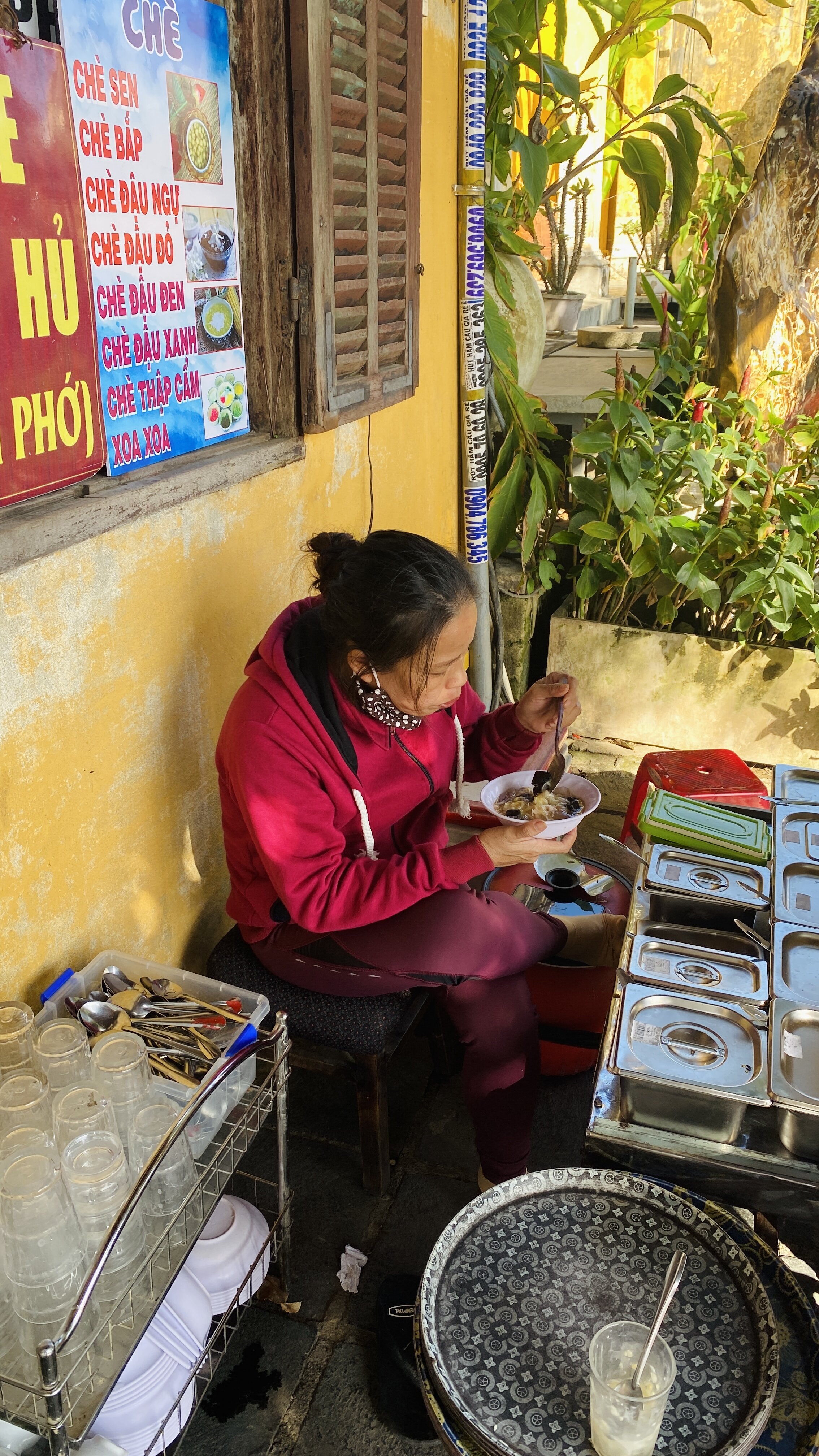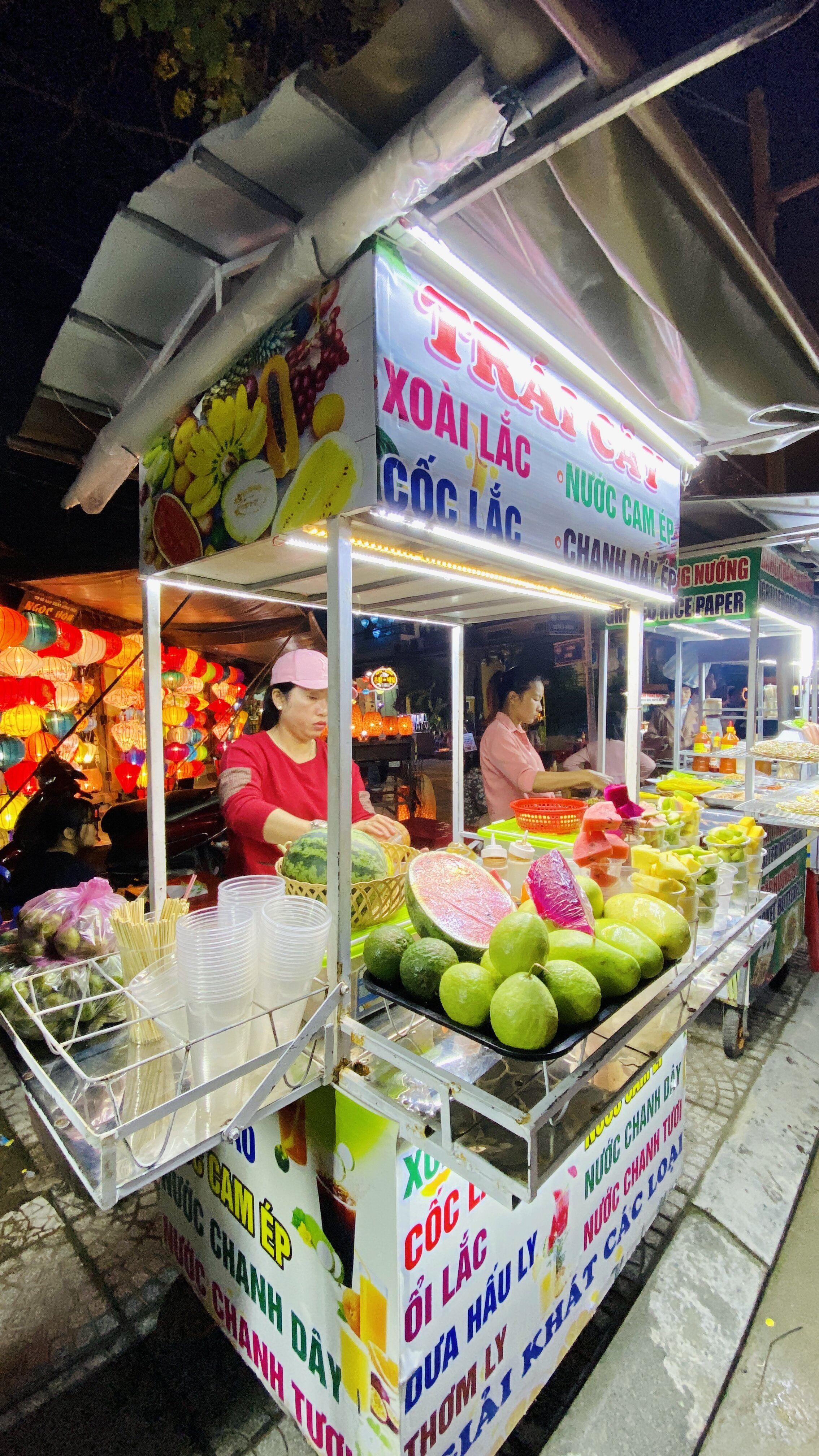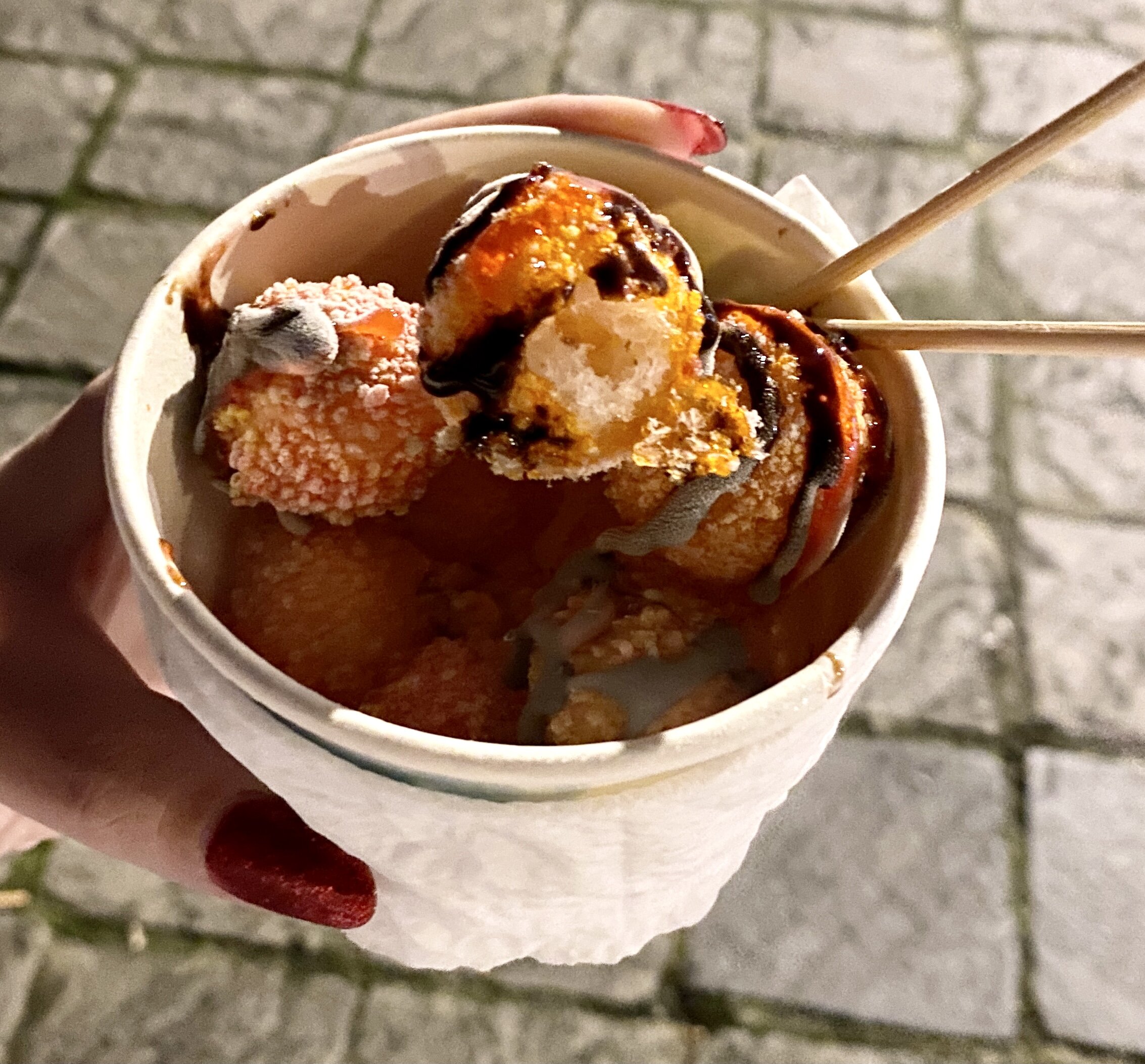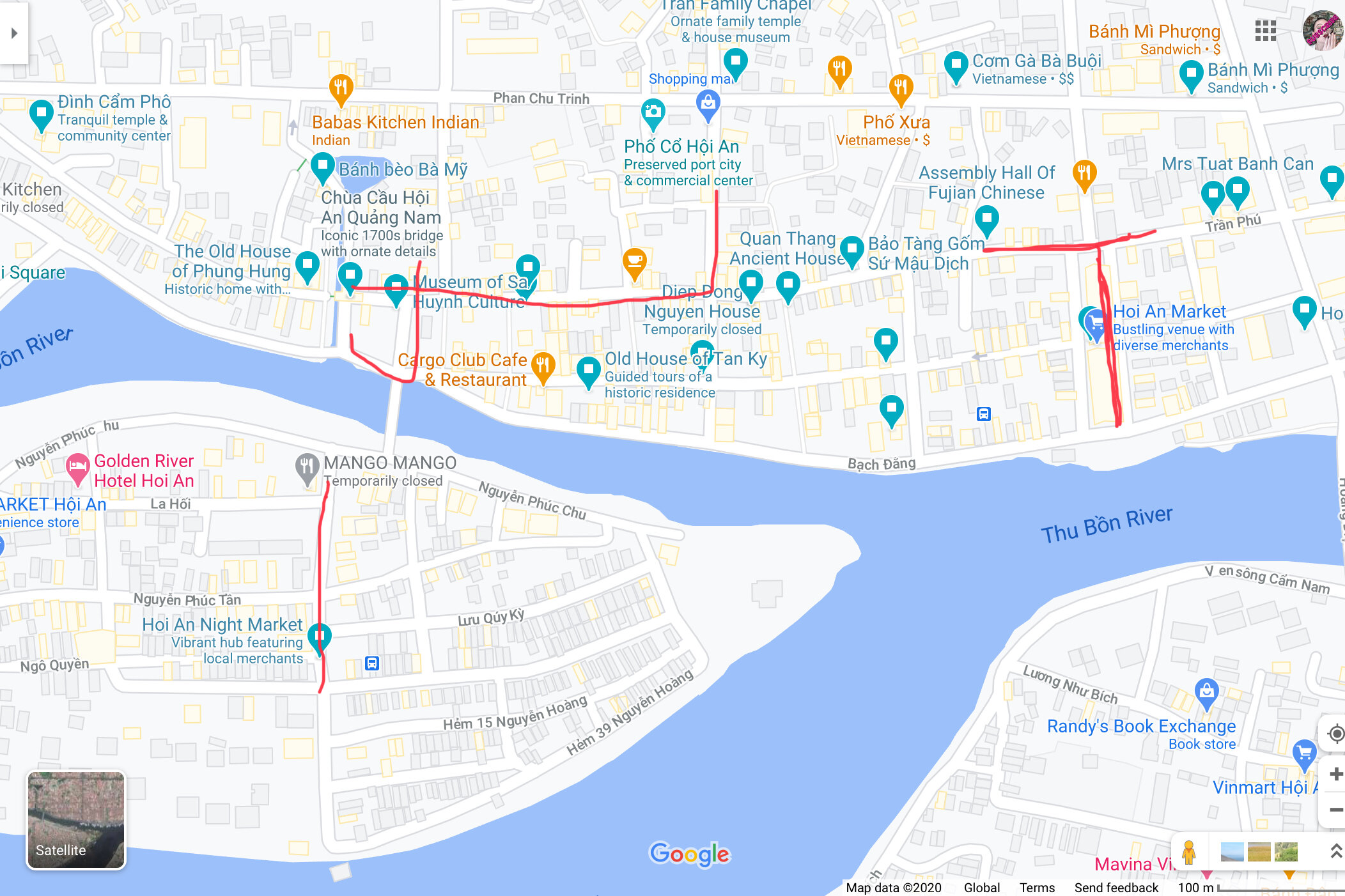I typically shy away from street food. Of course the hygiene is questionable relative to a restaurant . . . Where does the server wash their hands, particularly after using the restroom? How are they washing utensils? Also, as a Westerner, any stand without posted prices will charge me much more than a local: walking in Hội An Old Town with my Vietnamese friends, a serving of anything is 15,000 dong; on my own, it’s 30,000 or 40,000. For reference, a sit down meal can be bought at a non-tourist restaurant for 35,000.
Even when I’m willing to risk my health and accept being scammed in the name of experiencing local culture, the element that typically makes me skip street food is the street itself: squatting at exhaust pipe height amongst chainsmoking locals, trash bags piled around every tree and sometimes burning in the street, is enough to make me feel ill before eating at all. The setting makes it pretty difficult to appreciate good flavors, and anything aggressively pungent can quickly become nauseating.
I was recently willing to give street food a chance in Hội An, because this discomfort factor has been mitigated by the Covid pandemic. Nine months after borders closed, and less than a month after several severe floods, this extremely tourist reliant town is dead, hands down the quietest of any I’ve visited in the country. There is no crowding and very little traffic; I could easily take my street food, walk a block and eat quietly in front of a boarded up museum, without aggressive scooter drivers or souvenir hawkers bothering me.
Hội An is also particularly well known for its local specialties, and with no tourists the street food is currently in its totally authentic state (sometimes food served to white people in tourist areas is prepared extra bland, extra sweet, or drowned in soy sauce, which obviously doesn’t appeal).
Spoiler alert: I still greatly prefer restaurants, and I’ll cover the best restaurants and must-try local dishes of Hội An in a separate post. Still, there is such vlogger/blogger/foodie fervor over Vietnamese street food that I’m glad I tried a lot of it.
I have 4 ‘ratings’:
Yuck
Meh
Would Eat Again
Wow
Here are my thoughts!
Bánh Bột Lọc
MEH.
These tiny dumplings have stretchy, tasteless rice wrappers and are filled with either a tiny, unshelled shrimp (you eat the head, tail and all, for a crunchy effect) or a lump of meat paste that I later learned was pork but was honestly indiscernible to me by taste alone. These were boring and made edible solely by the generous topping of fish sauce, chili jam and fried onions.
Bánh Xoài
MEH.
These are the infamous mango-free “mango cakes”: thick, glutinous rice balls dusted in powdered sugar or flour (very mochi-like) and filled with roughly ground peanuts, granulated sugar, and a bit of cinnamon if you’re lucky. If Bánh Mì is the Việt equivalent of a breakfast sandwich, these are Việt donuts: you snag one or two and eat them standing up on the corner, coffee (or tea) in the other hand, regretting it more with every bite. The sugar is so rough that I was genuinely concerned about cracking a tooth! And dare I say they don’t look like mangoes either?
Chè Bắp
would eat again.
There are about a trillion kinds of chè; the wikipedia page is quite illustrative if you are curious. The most common is definitely Chè Bắp, a corn and tapioca starch pudding drizzled with coconut cream. It’s served hot and cold, and is tasty both ways. It’s sweet, but not too sweet, and was good enough for me to experiment with some other types of chè . . .
Chè Thịt Quay
WOULD EAT AGAIN.
These are small glutinous rice balls filled with tiny bits of roasted pork, floating in a hot sugary broth seasoned with sesame, ginger and sometimes cinnamon. The contrast of sweet and salty is great; this reminds me of the flavors in a traditional moon cake.
Chè Hạt Sen
Would eat again.
To me, the least interesting types of chè are those served with jellies over ice. However, I approach my food listicles as a completionist, and these were clearly the most popular versions. I heard somewhere that lotus seed chè was trendy cuisine in the 19th c. Imperial City, which is almost correct: the imperial chè was actually lotus seed stuffed longans in vanilla and jasmine flower soup (needless to say, too expensive and time consuming for street vendors to bother with). I still really enjoyed my poor man’s version, which was a nice balance of sweet and starchy. As the ice melted into the syrup, it became a really refreshing drink. It opened my mind to the various bean iterations on offer . . .
It’s official: I’m a chè convert.
Đậu Hũ
Meh.
Đậu Hũ, Đậu Phũ, Tào phớ and Tàu phớ are all transliterations of “tofu”, and refer to the same dish. The dessert features a slightly sweet soy custard topped with oversweet runny caramel syrup, miscellaneous jellies, and occasionally a spoonful of chè (the above pictured has chè đậu xanh, or mung bean pudding) or shaved coconut. It’s served either hot or over ice. It’s so pretty that I really wanted to like it. It also tasted so familiar, so nostalgic, that I bought it from three different vendors despite not really liking it, trying to place it . . .
Flan. It’s the mediocre flan your second generation Puerto Rican aunt would bring to your birthday party and everyone ate because she tried and she’s an RN and no one is good at everything so be nice! A forgettable prelude to the Carvel cake. My favorite was Fudgie the Whale. Also, this could be a lot better with half-frozen berries on top instead of almost flavorless jellies. Anyway . . .
Bánh Tráng Nướng
Wow.
Your choice of seasoned dried beef, shrimp or chicken (I chose shrimp and chicken) are layered with green onions atop a thin fermented rice shell. The heat is turned on, a quail egg is cracked on top and cooks as it flows into and blends the other ingredients, and the whole thing is finished with a drizzle each of mayo and chili sauce. If you’re sitting down to eat it’s served open faced; if you get it to go it will be folded over, quickly flipped and handed to you in a paper pocket. Yet another Việt street food with a hmmm . .. kinda I guess? English nickname, this is commonly referred to as ‘Vietnamese pizza”. It’s much closer to a tostada, in my opinion. Delicious!
Bánh Khọt
Wow.
Dung is the place in town to go for bánh khọt, with foodies and locals packing her stand all day. She also has two employees frying and packing the shells for wholesale to restaurants. The shells are made of rice flour, corn starch, and coconut milk, tinged yellow with turmeric, and fried in a griddle. The filling is typically fried egg, and deluxe versions can include a shrimp or shredded chicken. The whole thing is topped off with fresh veggies, and enough nước mắm pha to make a soup at the bottom of the bowl. This meal gives the satisfaction of fried food, but I find it much less heavy and oily than bánh xèo. Dung doesn’t serve shrimp or chicken, but tops her dish off with a generous slice of fried pork, for a salty/sweet contrast and a really filling meal.
Xí Mà
Would eat again.
This sweet black soup is surprisingly elusive. It’s served by one family only; they grow sesame plants in their garden and make the soup with water from the Bá Lễ well, which is only a few steps from their home. It’s served to tourists as part of a cooking demonstration in their kitchen, and to locals on the sidewalk across from the Catholic Church.
It’s considered a special occasion when the octogenarians (who started selling the soup 50 years ago) get out on the sidewalk and sell themselves; it’s usually the younger generation who will do it now. The simplicity of this soup and it’s low price (10,000 dong/bowl) have made it a popular local breakfast for many years. I like it enough to buy if the family is out that day and I happen past, but not enough to look and look for it on different days, at different times, many days in a row, as I had to.
Trái Cây
Wow.
Probably the healthiest street food ever, fruit cups are simple: pick your fruit (mango, guava, watermelon, avocado, dragonfruit, pineapple, etc.) then choose sweet or spicy. Sweet is dressed with a drizzle of chocolate or caramel syrup; spicy is dressed with a red pepper or chili based syrup, then shaken. My favorite (pictured here) is spicy mango.
Bánh Dừa Nướng
Would eat again.
These are French crèpes in a different shape; it’s the exact same taste and texture, but instead of the folded envelope/cone I’m used to, the dough was artfully shaped into a sort of clamshell. The filling is shaved coconut, toasted peanuts and a bit of chocolate syrup; nothing special, but satisfying nonetheless if you like sweets.
Kem Khói Hàn Quốc
Yuck.
Hàn Quốc means Korean, and this dessert is definitely as flashy and trendy as everything else that seems to filter down to Vietnam from Kpop culture. I had to look up what exactly this is, because it wasn’t ice cream as advertised! Truly light as air, fried yet completely flavorless, the brightly dyed balls are drizzled with chocolate syrup and disgustingly sweet strawberry flavored syrup. Then, the whole thing is sprayed with liquid nitrogen, instantly freezing it and creating the smoke effect.
If you eat it before the smoke dissipates, the smoke will come out of your nose and mouth while you eat and breathe, so this is marketed as ‘dragon’s breath ice cream.’ It looks cool, but could look a lot better with more sophisticated shapes and colors. It tastes awful; all I could taste was the saccharine over-sweetness of the fake strawberry syrup. I was done after 3 or 4 balls, but it still left my mouth feeling numb and coated. This is more an edible toy for children and Instagrammers than food.
Khoai Tây
Meh.
These seemed to be the least popular option in the tourist area and the most common option in the non-tourist area, so I was curious. They’re grilled cakes of mashed sweet potatoes mixed with a few small bits of banana, coconut, or green beans. They don’t taste great and they don’t taste bad; they really don’t taste much different than the rinsed and grilled whole sweet potatoes you can buy for the same price three feet away.
They would taste a lot better deep fried, or at least buttered before they were grilled; they could really take off with both bigger bits of fruit and more creative choices, like pineapple, or caramelized peppers and onions, or blueberries. However, these are an old-fashioned subsistence food for locals who need to eat on $1-2/day, not an experimental foodie culture item.
Where to Buy Street Food
Street food is truly ubiquitous in Hội An; I genuinely don’t think you could walk down a single block without passing a vendor. If you have as little as 20,000 dong (less than $1) you will not go hungry here. It’s sometimes difficult to find the same vendor twice because most will rotate within the same couple blocks just for variety, and others get shuffled off their corners every now and then by police officers cracking down on unlicensed sellers. However, if you are looking to try a large variety of foods without walking too far, these are the hubs:
All Hours:
Châu Thượng Văn, for the whole block north of the Bridge of Lights, is packed with sellers at all hours; they spread out heading towards the Japanese covered bridge along the river, and stretch west along Trần Phú for a few blocks before turning northwards on Lê Lợi for a block or two.
Early Morning Only:
Chợ Hội An (the Hoi An market) has a really large indoor food court where local specialties are sold to locals (so extremely authentic foods and a lot of variety). However, it empties out after 10 AM, with 3/4 of the sellers going home, and by noon it’s just a few local businessmen eating lunch. On the north front of the market, and for a couple blocks of Trần Phú on either side of the entrance, are many more sellers.
Evening Only:
On An Hội island (across the Thu Bồn river from the old town) there is a nightly evening market on 2-3 blocks of Nguyễn Hoàng. They sell the local classics as well as more modern sweet treats like Nutella pancakes. There are also a couple bars here with live music and a nice evening scene. Things start up around 7:00 PM.







































































